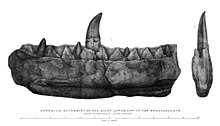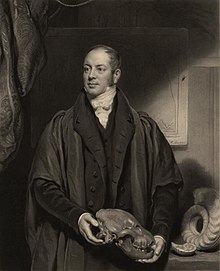William Buckland
William Buckland (born March 12, 1784 in Axminster , † August 24, 1856 in Islip ) was an English theologian and one of the most important geologists and paleontologists in the early days of this science. He was the first scientific descriptor of Megalosaurus , one of the first three known dinosaurs . In 1823 he also discovered the world's first fossil of an individual of the genus Homo , the so-called Red Lady of Paviland .
life and work

Buckland was born in Axminster , Devon in the UK . He studied at Corpus Christi College Oxford , where he was given a lectureship in mineralogy in 1813 as a successor to John Kidd , who followed in 1819 in geology . In 1818 he became a member of the Royal Society and from 1824 to 1826 and again from 1839 to 1841 he was President of the Geological Society of London . In 1822 he was elected a member of the Leopoldina , and in 1825 he was elected to the American Academy of Arts and Sciences . In 1838 Buckland was introduced by James Roberton († 1840) as member number 141 of the Société cuviérienne . From 1839 he was a corresponding member of the Académie des sciences . In 1847 he was appointed to the board of directors of the British Museum and in 1848 received the Wollaston Medal from the Geological Society of London.
Buckland's reputation as a geologist and paleontologist is based on his published scientific work. In his book Relics of the Deluge (1823) he commented on the fossil record of extinct animals found in the Kirkdale Caves in Yorkshire with reference to the biblical account of Noah's Ark . Until, under the influence of Louis Agassiz, Buckland was a proponent of the flood theory . In his inaugural Oxford lecture (entitled “A Declaration of the Connection between Geology and Religion”), he named it as the goal of geology: “to confirm the testimonies of natural religion; and to show that the facts they developed coincide with the accounts of creation and the Flood in the Mosaic Scriptures ” .
After meeting Louis Agassiz, he developed into an early proponent of Agassiz's glacier theory and then worked intensively on finding evidence of a former glaciation in Great Britain.
The Dorsum Buckland on the Earth's moon is named after him.
Frank Buckland (1826–1880), son of William Buckland, was a surgeon and journalist; he is known for Curiosities of Natural History .
Honors
Robert Brown probably named the genus Bucklandia R.Br. after him. ex handle. from the witch hazel family (Hamamelidaceae), later renamed Exbucklandia R.W.Br. was renamed.
Eccentricity

William Buckland was a colorful personality and known as an eccentric , who also carried out field research in an academic robe and top hat and liked to entertain evening parties with amusing lectures on his latest bone finds. He always carried a blue bag with him, which he filled with geological finds picked up along the way. On his premises in Oxford and Westminster, Buckland housed a large number of animals, some of which were exotic, and which often roamed free. Buckland was also known for his gastronomic experiments. He is said to have had the ambition to eat his way through the entire animal kingdom by eating a specimen of every known species.
Fonts (selection)
Books
- Vindiciae Geologicae; or the Connection of Geology with Religion explained in an Augural Lecture delivered before the University of Oxford, May 15th, 1819, on the Endowment of a Readership in Geology by HRH the Prince Regent (1820)
- Reliquiae Diluvianae: or, observations on the organic remains contained in caves, fissures and diluvial gravel and on other geological phenomena, attesting the action of an universal deluge (1823)
- On Geology and mineralogy considered with reference to natural theology (1836)
items
- Account of an Assemblage of Fossil Teeth and Bones of elephant, rhinoceros, hippopotamus, bear, tiger, hyena, and sixteen other animals, discovered in a cave at Kirkdale, Yorkshire, in the year 1821 (1822)
- Notice on the Megalosaurus, or Great Fossil Lizard of Stonesfield (1824)
- On the Fossil Remains of the Megatherium recently imported into England from South America (1832)
Fonts available online
- Geology and mineralogy in relation to natural theology. By Rev. Dr William Buckland. From the English, from the second edition of the original Geology and Mineralogy considered with reference to Natural Theology (one of the Bridgewater Treatises ), translated and annotated by Dr L. Agassiz. First volume, text. Neuchatel: Printed by Petitpierre. Published by Eduard Leibrock, bookseller in Braunschweig, 1838 and 1839. Complete online edition 1838 , complete online edition 1839
literature
- Deborah Cadbury: Dinosaur Hunters: The Race to Explore the Prehistoric World . Rowohlt, Reinbek near Hamburg 2001, ISBN 3-498-00924-9 .
- Elizabeth Oke Gordon: The life and correspondence of William Buckland, DD, FRS: sometime dean of Westminster, twice president of the Geological society, and first president of the British association . J. Murray, London 1894.
- Martin Rudwick : Worlds Before Adam: the Reconstruction of Geohistory in the Age of Reform . University of Chicago Press, Chicago 2008, ISBN 0-226-73128-6 .
- Nicolaas Rupke : The Great Chain of History: William Buckland and the English School of Geology . Clarendon Press, Oxford 1983.
- Société Cuvierienne: Admis dans la Société Cuvierienne . In: Revue Zoologique par La Société Cuvierienne . tape 1 , 1838, p. 240 ( biodiversitylibrary.org ).
Web links
- Entry to Buckland; William (1784-1856); Dean of Westminster, Geologist at the Royal Society Archives , London
- asa3.org: William Buckland in Retrospect (English)
Individual evidence
- ^ Société cuviérienne, p. 240.
- ^ Directory of members since 1666: Letter B. Académie des sciences, accessed on September 29, 2019 (French).
- ↑ Lotte Burkhardt: Directory of eponymous plant names . Extended Edition. Botanic Garden and Botanical Museum Berlin, Free University Berlin Berlin 2018. [1]
- ↑ Elizabeth Oke Gordon: The life and correspondence of William Buckland , p. 102
- ^ Elizabeth Oke Gordon: The life and correspondence of William Buckland , p. 104
| personal data | |
|---|---|
| SURNAME | Buckland, William |
| BRIEF DESCRIPTION | English geologist and paleontologist |
| DATE OF BIRTH | March 12, 1784 |
| PLACE OF BIRTH | Axminster , Devon |
| DATE OF DEATH | August 24, 1856 |
| Place of death | Islip (Oxfordshire) |
